Plantar Fasciitis in Triathletes - How to Overcome It

Pierre
1/17/2025

Have you ever felt that sharp pain in your heel after a good running session?
If that rings a bell, then yes, you’re probably dealing with the infamous plantar fasciitis, also known as plantar fasciopathy.
Don’t worry, this article will guide you to better understand what it is and how to recover quickly, without losing your passion for triathlon.
What is plantar fasciitis?
Plantar fasciitis is an inflammation of the band of tissue that spans the sole of your foot, called the plantar fascia.
This fascia connects your heel to your toes and absorbs shocks with every step. Naturally, when you do triathlon, especially running, this band is subjected to significant strain.
This can lead to pain and discomfort, particularly during periods of intense training.
Symptoms of plantar fasciitis
The symptoms of plantar fasciitis often manifest as follows:
-
Heel pain that can sometimes radiate across a large part of the arch of the foot or even up to the ankle.
-
Pain in the morning, after long periods of rest, or after a running session.
-
A feeling of stiffness in the foot, which can reduce mobility.
If you feel a sharp pain when massaging your arch, particularly around the heel, there’s a strong chance you’re dealing with plantar fasciitis.
How to Get Rid of Plantar Fasciitis as a Triathlete
Don’t panic! There are several strategies to recover effectively in just a few weeks. But first, let me answer a question you’re probably asking yourself:
Should I stop running?
When you feel pain, it’s important to ask this question. But, as often, the answer isn’t a simple yes or no...
If you feel mild pain after 30 minutes of running, reduce the duration and intensity of your sessions; it seems you can continue running carefully.
On the other hand, if you experience significant pain during daily activities, the answer is clear—rest is necessary.
Whatever your situation, follow the three phases below to determine where you are and what you can do to eliminate plantar fasciitis.
Phase 1: Inflammation
This is the acute phase where inflammation of the plantar fascia occurs. Unsurprisingly, during this phase, it’s better not to push yourself...
It’s best to take a few days off from running (or any other activities that involve standing on your feet).
However, a complete stop in sports isn’t advisable as it could be counterproductive. You can continue swimming or cycling if you don’t feel any discomfort.
During this phase, focus on reducing pain. Start with stretches and self-massages of the sole of your foot.
Here are two examples of exercises to do daily (ideally several times a day):
Sit on a chair, place your ankle on your knee, and grab all your toes with one hand, pulling them toward you. In this position, your arch should feel well-stretched; if not, pull a bit harder. Hold this position for 20 seconds, then switch to the other foot. Do three sets on each foot.
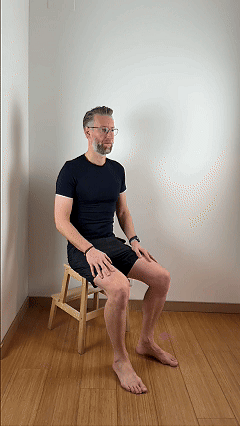
Use a self-massage ball or a tennis ball to relax your arch. Take the time to explore every area of your foot, inch by inch. This isn’t about rolling quickly like a "rolling pin"—move slowly and deliberately.
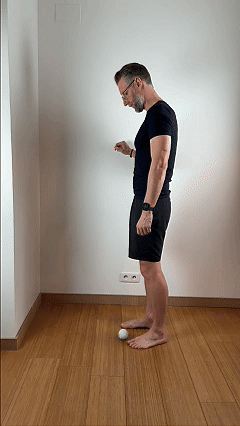
You can also wear shoes with good heel cushioning (forget flip-flops!) or add a heel pad to relieve your pain.
After a few days, your pain should have decreased or even disappeared. Then, you can move on to the next phase.
Phase 2: Rehabilitation
During this second phase, we’ll work on different areas to ensure your plantar fasciitis becomes a distant memory.
Even if you no longer feel pain at this stage, don’t resume running—it would be counterproductive and might force you to restart phase 1, lengthening your recovery time.
Here are some exercises you can do daily for 1–2 weeks:
- Two-foot calf raises and descents (with a towel and a step or book), 3 sets of 12 reps.
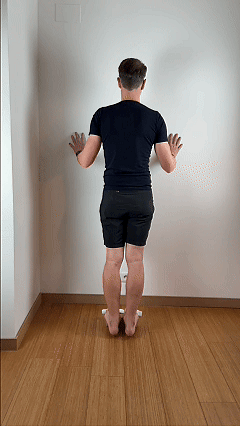
- Foot and calf stretch (20–30 seconds): Stand facing a wall, place your hands on the wall, step one leg back while keeping the other leg slightly bent, press your back heel to the ground, and lean slightly toward the wall.
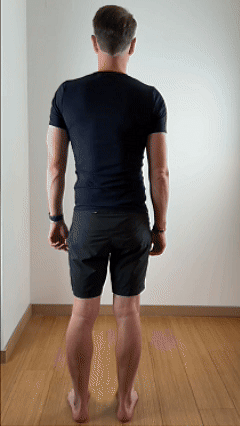
After a few days, modify your routine and use the following exercises every other day:
- Two-foot rise, one-foot descent (with a towel and a step or book), 3 sets of 12 reps.
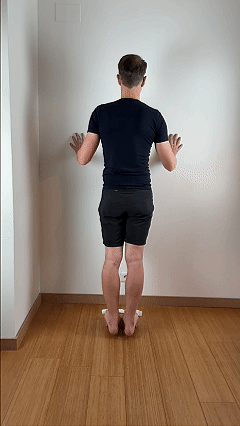
- Repeat the foot and calf stretch as described earlier.

Gradually, reintroduce light running sessions, starting with short 10–15 minute jogs.
If you don’t feel any pain, increase the duration by 5 minutes at your next session.
Keep doing the exercises and stretches every two days. After a few sessions, you should be able to run for an hour without pain.
If so, you can introduce some plyometric exercises as an additional step:
- On one leg, do 10 jumps forward/backward and left/right. Perform 3 sets for each leg.
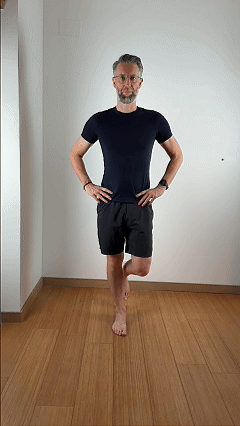
Over the weeks, you should no longer feel any pain. However, this doesn’t mean you can stop the exercises—continue for 12 weeks to consolidate your progress.
Phase 3: Strengthening
It’s much easier to prevent than to treat, isn’t it? That’s why, after 12 weeks of being pain-free, you need to maintain your results and focus on prevention. Here are the key points to consider:
-
Include strength training in your weekly routine to prevent recurrence or other injuries.
-
Pay attention to your diet: Nutrition plays a key role in recovery.
-
Choose appropriate shoes: Invest in running shoes with good cushioning.
-
Vary your training surfaces: Running on hard surfaces like asphalt increases impact, so mix in trail or treadmill running to give your feet a break.
-
Monitor your weight: Excess weight adds considerable pressure on your feet.
With Patience, Recovery Is Within Reach!
If you’re a passionate triathlete suffering from plantar fasciitis, remember that recovery is possible. With the right exercises and a bit of patience (we know that’s not always easy), you’ll be on the road to recovery.
Want to Go Further?
Looking to improve your triathlon practice by working on physical training, nutrition, and mental preparation? Take advantage of a 7-day free trial: Click here to try SupaTriathlete!
Take care of your feet, and remember: happy feet make a happy triathlete! 😊
Join a Community of Like-Minded Triathletes
What if you could be part of a platform designed by and for triathletes?
Because triathlon isn’t just about combining three sports...
I’m building a platform to meet the real needs of triathletes, whether beginner or experienced. The goal is simple: to help you progress with tools and features that make your life easier. But for that, I need your input!
👉 Join the waiting list for free, gain access to our platform, and help us build it based on your needs. You’ll be able to request the features you really need and have your voice heard. Together, we’ll create THE platform every triathlete has been waiting for.
💻 Click here to sign up for free and share your ideas
See you on the other side? Can’t wait to hear your ideas! 🚀